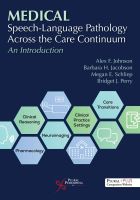A New Look at Medical Speech-Language Pathology

Medical Speech-Language Pathology Across the Care Continuum: An Introduction was developed with very specific objectives in mind. These key objectives were to address real world speech-language pathology practice in healthcare settings, focusing on common issues and challenges; to meet the needs of new clinicians and graduate students; and to include authors with expertise in the settings where contemporary SLPs practice.
When we reviewed available books in this field, no other text set out to tackle the reality of the settings where care is provided. Thus, we decided to create a text that would be useful in linking important principles of evidence-based practice with real-world health care settings. In this book we cover the continuum of care, moving from acute care, rehabilitation, home care, skilled nursing, outpatient, and specialty settings. We also included a chapter on pediatric medical speech-language pathology. Our hope is that readers will find this “real-world” orientation to be a useful supplement to their in-depth study of the various speech, language, cognitive, and swallowing disorders. We have intentionally balanced discussion of “disorder” with “context” (setting discussion). This approach provides a great advantage for both the instructor and the learner.
We were interested in creating a text that would be useful for the growing number of courses in graduate medical speech-language pathology programs and have organized the text and its content with the novice learner in mind. Our intent was to make it interesting and readable, and particularly useful to students facing their medical internships and clinical fellowships. They are the audience that is most in need of the preparation this material provides.
Our contributors to the text have extensive clinical and academic experience. They have prepared chapters with an abundance of tables, clinical examples, and images that can be useful for work in the classroom, but also for handy reference as clinicians begin their work in medical SLP.
Of particular interest are two chapters absent from other medical speech-language pathology texts. These are chapters on pharmacology and neuroimaging. These two areas of are increasing importance in clinical interactions in medical settings but are not always routinely addressed within a graduate program. Both chapters have been written to provide the basics for the new learner, so that they can use the information in their clinical practice across settings. Also included is a comprehensive appendix of medical tests and reference values for various laboratory tests. All of this has been assembled with the new clinician in mind and hopefully provides additional resources to their clinical toolkit. This content, combined with the information from various settings, provides a comprehensive view of clinical work in modern medical speech-language pathology.
The book was also designed with consideration for the busy instructor. Key chapters can be utilized to design a semester long course, with substantial material for added consideration as needed. Notably, the final chapter of the book contains cases that have been prepared to provide content for class discussions or projects. Each case represents concerns that are typical in and across various clinical settings and cover a broad range of communication and swallowing symptomatology.
